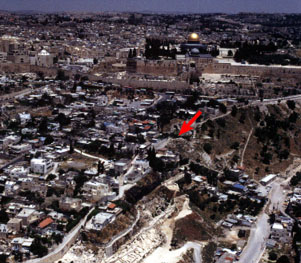
JERUSALEM, Israel - Of all the personalities in the Bible, have you ever wondered whose name other than Jesus is mentioned most often?
This personality was a fierce and terrible warrior, yet a great poet. He was a spiritual man, but also humanly imperfect, a sinner. Anointed and beloved by God, this leader was a shrewd and relentless politician, but also a kind-hearted and benevolent statesman. He was a ruthless empire builder, yet was often compassionate, and humble; he cared for his people.
 |
An aerial photo of the most ancient part of Jerusalem and the Jebusite city conquered and ruled by King David. The arrow marks the location of the Palace of King David identified by Hebrew University archaeologist, Dr. Eilat Mazar. |
"Very few personalities in history stir our imagination as that of David, son of Jesse," says historian, M. H. Leon.
Anointed by the prophet Samuel at God's command, King David founded a dynasty which ruled Israel from Jerusalem for almost 500 years and established the lineage which brought forth the Savior of all mankind. His name is found both in the very first verse of the New Testament (Matt 1), and at the end of the Bible, in the very last chapter of the Book of Revelation. (22:16)
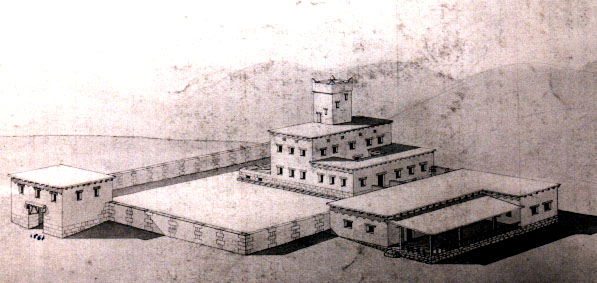 |
An architectural reconstruction of the Phoenician-built Palace of King David, built after his conquest of Jerusalem in the 10th century B.C. |
King David brought God's tabernacle from the wilderness to its final home in Jerusalem. He expanded the city, which showed very little growth in the thousand years prior to his arrival, and made it the spiritual and economic capital of the world of his time.
The book of 2Samuel (5:9) states that, after he conquered Jerusalem, King David made it his capital. "David then took up residence in the fortress and called it the City of David. He built up the area around it, from the supporting terraces inward." (NIV) At the same time, the Phoenician King Hiram of Tyre offered to build him a palace fit for an emperor. (2Samuel 5:11, 1Chronicles 14:1)
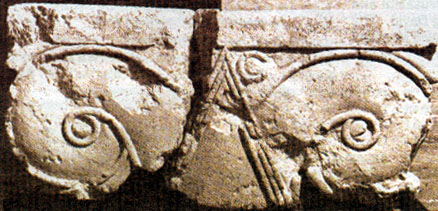 |
A square column that was part of the Palace of King David includes a capital which is characteristic of Phoenician stone masonry work. This is a further validation of the biblical narrative, which records that King Hiram of the Phoenicians, "sent messengers to David, along with... stone masons, and they built a palace for David." (2Samuel 5:11, NIV) |
It was in this same palace that, "David got up from his bed and walked around on the roof of the palace. From the roof he saw a woman bathing. The woman was very beautiful... [and her name was] Bathsheba..." (2Samuel 11:2, NIV)
"For decades," says Leon, "and despite much effort by scholars and archaeologists, the location of King David 's palace has remained a mystery."
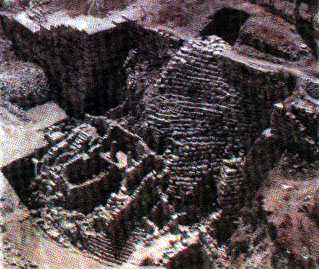 |
Part of the fortifications of the citadel, next to which King David built his palace. (2Samuel 5:9, 2Samuel 5:11) It was in this same palace that, "David got up from his bed and walked around on the roof of the palace. From the roof he saw a woman bathing. The woman was very beautiful... [and her name was] Bathsheba..." (2Samuel 11:2, NIV) |
But recent discoveries and research by Hebrew University archaeologist, Dr. Eilat Mazar, the granddaughter of the renowned archaeologist, the late Prof. Benjamin Mazar, has unveiled convincing evidence that pinpoints the exact location of this most important biblical structure.
"The discovery of the location of the palace of King David is of extreme importance to our understanding of ancient Jerusalem," says Dr. Mazar, in an exclusive interview with the Jerusalem Christian Review. "We now have tangible remains of the place where the most famous king in history once lived."
"In fact," says Leon, "we know quite a bit about this palace from the Bible." It was "a house of cedars" (1Chronicles 17:1), built by Phoenician builders (2Samuel 5:11 & 1Chronicles 14:1) who used the cedars of Lebanon and developed a distinct style of stone masonry.
King Hiram of the Phoenicians offered King David to build him a palace fit for an emperor (2Samuel 5:11; 1Chronicles 14:1): "Now Hiram king of Tyre sent messengers to David, along with cedar logs and carpenters and stone masons, and they built a palace for David." (2Samuel 5:11, NIV)
"One of the reasons researchers were at a loss in finding this important place was that they assumed that King David, as logic would dictate, built his home in the safest, best protected part of the city, inside the Jebusite city walls," says Mazar. However, this was not the case.
The Jebusite city, while almost impregnable, was also very small, approximately 9 acres in size. Nevertheless, scholars continued to search for King David's residence within the city walls. No remains were found that pointed to the existence of a great palace like that which the Bible describes, and scholars began to doubt biblical claims that such a grand structure ever really existed.
"But one of the main clues in finding King David's palace," says Mazar, "was surprisingly from the Bible itself." 2Samuel 5:17 states that: "When the Philistines heard that David had been anointed king over Israel, they went up in full force to search for him, but David heard about it and went DOWN [from his palace] to the [citadel]." (NIV, capitalization added for emphases)
Although the Philistines were defeated by King David's forces, the Bible is careful to indicate that the palace was located above the "Me'tsuda" (the citadel or stronghold). "The Bible would not have said 'went down' unless David indeed did go from his palace, down the slopes of the ophel mountain, to the citadel. Consequently, his palace must have been located north of the city, not in the center of it," says Mazar.
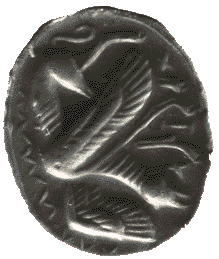 | A seal from the early Israelite period, with the motifs of a griffin and a beetle, found just beyond the northern wall of the newly discovered Palace of King David. |
The Philistine invasion took place after the completion of David's new palace, but before the northern fortifications were sufficiently finished. Therefore, King David, who was already living in his new residence, which was not yet strong enough to withstand a major assault from the north, decided to retreat for a time to the old Jebusite fortress, the "Me'tsuda," south of his palace.
Although King David conquered the city from the Jebusites, he permitted them to remain. Dr. Mazar reasoned that with David's followers and members of his administration flocking into Jerusalem, the nine-acre city quickly became overcrowded.
"There was no way it could accommodate an imperial palace, as well as new residences for all his officers and their families," says Mazar. Since the areas to the south, east, and west were fully built-up and stood on the brink of steep slopes, David must have built his new palace north of the walls of the Jebusite city.
"This area was not only available but also desirable. It was protected on the south by the citadel and the old city, and on the east and west by the deep slopes of the Kidron and Tyropoeon valleys." Later, 1Samuel 5:9 tells of the construction of formidable fortifications which were completed to the north by David's heir, King Solomon.
Dr. Mazar also drew conclusions based not only on her excavations but on previous studies as well. One of the most significant discoveries was made by British archaeologist, Dr. Kathleen Kenyon, north of the citadel.
"She discovered a 4th century B. C. wall," says Mazar, "built on a platform based on a much older perpendicular artificial precipice." Underneath was a level of well-made stone blocks, among them a square column with a capital, identical to other such capitals previously found in Samaria and Megiddo. These belonged to the Israelite period. Phoenician masons were employed, leaving their mark on the decorative style of the time, a further validation of the biblical account. (2Samuel 5:11 & 1Chronicles 14:1) This find indicates that a grandiose early Israelite building must have stood there on top of the precipice.
Later, in 1980, the Hebrew University archaeologist, the late Prof. Yigal Shiloh, digging not far from Dr. Kenyon's excavations, found several more columns of the same style which probably fell from the palatial building which once stood there.
Further evidence was discovered in the northeastern part of the same area. A wall, with a series of small rooms built so as to form a strong outside wall, resembles the corner of a courtyard in a monumental building. "It is quite probable that this wall was fashioned in the style that belonged to a palace of the late Canaanite or early Israelite period," says Mazar. This can only be King David's royal palace.
Later, as the Bible records, King Solomon built his own palace, known as the "upper king's house" (Nehemiah 3:25) which was located farther to the north and closer to the site of the Temple. However, King David's palace, now referred to as the "lower king's house," continued to serve the kings of Israel and Judea for many generations to follow.
"There is no question that King David's palace was a magnificent and impressive structure," says Leon. "But much more of his home remains buried under generations of rubble."
"Only by continuing to excavate will we be able to truly understand the extent and grandeur of King David's royal house," says Dr. Mazar.
"After all," added the archaeologist, "finding his royal residence opens a new window of understanding into the life of a man who has affected the world more than any other king in the history of mankind."
Copyright © 1998 Jerusalem Christian Review. All rights reserved.
This article was reprinted with permission from the Jerusalem Christian Review, Volume 9, Internet Edition,
Issue 6.
For more information, please see the Jerusalem Christian Review site.